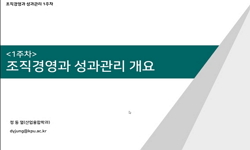The quality system such as ISO 9000 is powerful for every companies to increase their own competitive power. Especially it's getting more important as because it's more globalized every day. The goals of this study are to review the ISO 9000, Cost Qu...
http://chineseinput.net/에서 pinyin(병음)방식으로 중국어를 변환할 수 있습니다.
변환된 중국어를 복사하여 사용하시면 됩니다.
- 中文 을 입력하시려면 zhongwen을 입력하시고 space를누르시면됩니다.
- 北京 을 입력하시려면 beijing을 입력하시고 space를 누르시면 됩니다.
品質시스템모델이 品質原價와 成果에 미치는 影響 : 레미콘제조업의 ISO 9000 인증요건을 중심으로 = (A) Study On The Influence of ISO 9000 on Quality Cost and Performance
한글로보기https://www.riss.kr/link?id=T10067175
- 저자
-
발행사항
제주 : 濟州大學校 經營大學院, 1998
-
학위논문사항
학위논문(석사) -- 제주대학교 경영대학원 , 회계학과 회계학전공 , 1999. 8
-
발행연도
1998
-
작성언어
한국어
- 주제어
-
KDC
325.9 판사항(4)
-
발행국(도시)
제주특별자치도
-
형태사항
v, 104p. : 삽도, 수표 ; 26cm.
-
일반주기명
참고문헌: p. 95-96
- 소장기관
-
0
상세조회 -
0
다운로드
부가정보
다국어 초록 (Multilingual Abstract)
The quality system such as ISO 9000 is powerful for every companies to increase their own competitive power. Especially it's getting more important as because it's more globalized every day.
The goals of this study are to review the ISO 9000, Cost Quality and Performance and analyze the relationship among quality system, cost quality and performance.
To attain these purpose, this study is consisted as following;
1) An Introduction
2) A Theological Background:
3) The State of Remicon Industry
4) Empirical Analysis and
5) Conclusion.
This study is completed by carrying out the theological and substantial approach. The domestic and foreign textbooks were widely used as references and the survey of the study with the method of questionnaires is done next to the reference books. 560 questionnaires have been distributed to remicon companies in Korea. Among 560 questionnaires, 108 returned and 101 of them were used for the analysis of this study. SPSS for Windows Release 8.0, the statistical package for social science was used for the substantial analysis.
Components of ISO 9000 quality system were used as the relevant variables for the analysis, and divided into 3 different factors. These 3 factors were named as followings; Factor related to internal quality audit and service, Factor related to design control and Factor related to management responsibility and contract.
These 3 factors are mail independent variables and quality cost and performance were used as dependent variables. To find out the effort of these 3 factors to the dependent variables, statistical techniques such as Correlation and Regression were used to approve the hypotheses. And T-test and Oneway ANOVA were used for other independent variables such as size of a company, and location of the company.
The analysis of the substantial investigation is as follows;
First, there were negative relationships between quality cost and the factor related to management responsibility and contract.
Second, there were very positive relationships between performance of a company and the components of ISO 9000.
Third, The longer company's history, the more being clear to the bottom at the components of ISO 9000.
Forth, The bigger size of a company, the more being clear to the bottom at the components of ISO 9000.
목차 (Table of Contents)
- 目次
- 제1장 서론 = 1
- 제1절 문제의 제기 및 연구목적 = 1
- 제2절 연구의 방법 및 논문의 구성 = 2
- 제2장 품질시스템·품질원가·성과에 대한 이론적 고찰 = 4
- 目次
- 제1장 서론 = 1
- 제1절 문제의 제기 및 연구목적 = 1
- 제2절 연구의 방법 및 논문의 구성 = 2
- 제2장 품질시스템·품질원가·성과에 대한 이론적 고찰 = 4
- 제1절 품질시스템 = 4
- 1. 품질시스템의 개념 = 4
- 1) 품질시스템의 개요 = 4
- 2) 품질시스템의 정의 = 5
- 3) 품질시스템 모델의 필요성 = 6
- 4) ISO 9000 인증제도의 품질시스템으로서의 특성 = 7
- 5) 품질시스템모델의 구성 = 8
- 2. 품질시스템의 인증절차 및 요건 = 10
- 1) 인증절차 = 10
- 2) 요건 = 12
- 3. 기존제도와 ISO 9000과의 비교 = 24
- 4. 각국의 인증현황 = 27
- 제2절 품질원가 = 35
- 1. 품질원가의 개념 = 35
- 2. 품질원가의 분류 및 측정 = 36
- 1) 예방원가 = 37
- 2) 평가원가 = 38
- 3) 실패원가 = 39
- 4) 소비자품질원가 = 40
- 5) 사회적품질원가 = 41
- 제3절 성과 = 42
- 1. 성과의 개념 = 42
- 2. 성과의 유형 및 측정 = 42
- 제3장 레미콘제조업의 품질시스템 현황 = 46
- 제1절 국내 레미콘제조업의 현황 = 46
- 1. 레미콘생산업체의 현황 = 46
- 제2절 ISO 9000의 실시현황 = 50
- 1. ISO 9000의 현황 = 50
- 2. 국내 품질시스템 인증제도의 현실 및 문제점 = 52
- 제4장 품질시스템의 실증분석 = 54
- 제1절 조사의 개요 = 54
- 1. 표본추출 및 자료수집 = 54
- 2. 설문의 구성 = 55
- 3. 분석방법 = 57
- 제2절 연구모형 및 가설의 설정 = 58
- 1. 연구모형 = 58
- 2. 가설 설정 = 59
- 3. 조작적 정의 = 61
- 제3절 실증분석의 결과= 63
- 1. 기술적 통계 = 63
- 1) 자료의 특성 = 63
- 2) ISO인증요건의 신뢰계수 및 요인분석 = 65
- 2. 가설의 검증 = 68
- 3. 분석결과의 요약 = 88
- 제5장 결론 = 92
- 참고문헌 = 95
- 1. 국내문헌 및 논문 = 95
- 2. 외국문헌 = 96
- Abstract = 97
- 설문지 = 100












